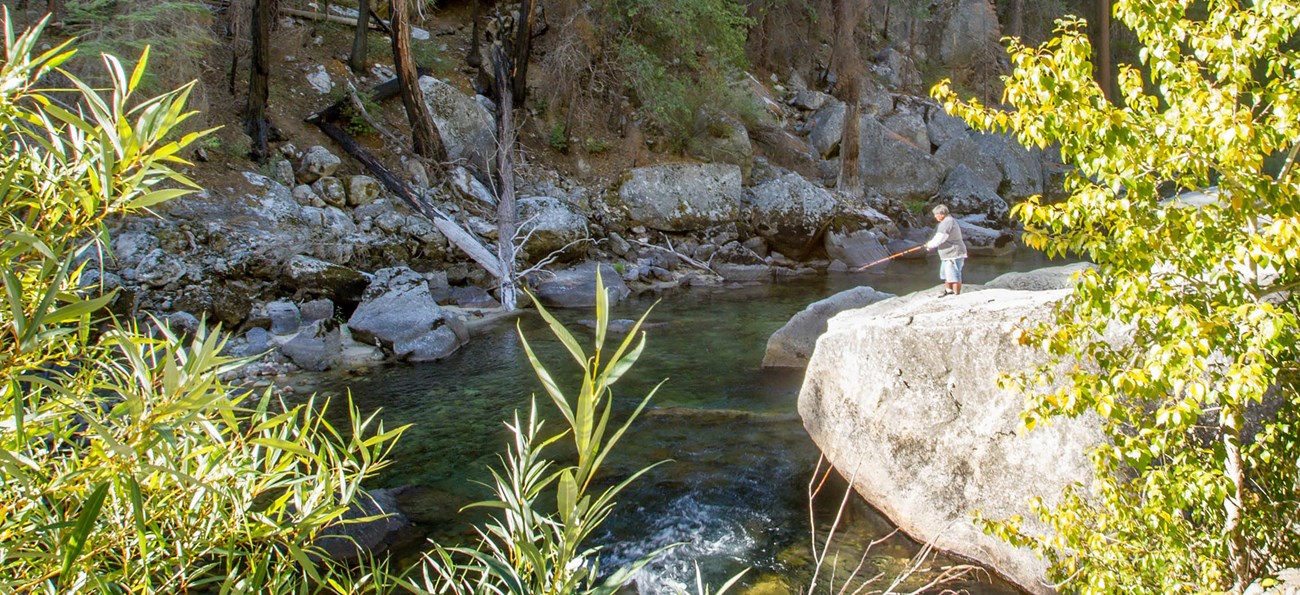Fishing - Sequoia & Kings Canyon National Parks (U.S. National Park Service) (original) (raw)

Photo by Kirke Wrench
Many go fishing all their lives without knowing that it is not fish they are after. ~ Henry David Thoreau
What comes to mind when you think about fishing? Patience, relaxation, challenge? These are but a few words often associated with fishing. We want you to have an enjoyable time fishing the waters of these parks and having memories that evoke these thoughts. But first, please take a moment to explore our fishing information and learn your responsibilities before casting a line into the water.
Licenses
Fishing is permitted in most areas of the parks, and on adjacent national forests. People 16 years of age or older are required to have a California fishing license. Get copies of park-specific regulations at any visitor center.
Licenses are not always available in park markets, so bring them with you, buy them in nearby communities before you enter the park, or get one at Hume Lake (north of the Grant Grove area). Tackle is available at most park markets.
Fishing Regulations
The open season for fishing and the daily bag limit and possession limit shall conform to that of the State of California fishing regulations throughout the park, except as otherwise provided below.
The following Special Regulation (see Compendium section 2.3) applies in addition to Federal and State law:
In waters below 9,000 feet in elevation that are not located in a Developed Area*:
- rainbow trout, Sacramento sucker, Kern rainbow, riffle sculpin, and California roach fish must be released
- only barbless artificial flies or lures are authorized
*A Developed Area is defined as an area within one-quarter (1/4) mile of buildings, campgrounds, picnic areas, or parking lots that accommodate more than five (5) vehicles.
The Code of Federal Regulations has more information about fishing in national parks.
Fish Consumption Advisories in National Park Waters
The Environmental Protection Agency, states, territories, and tribes provide advice on fish caught in the waters in their jurisdiction to help people make informed decisions about eating fish. Advisories are recommendations to limit your consumption of, or avoid eating entirely, certain species of fish from specific bodies of water due to chemical or biological contamination.
While some aquatic toxins are the result of natural biological processes, others are human-derived. Chemicals that originate outside of park boundaries and are toxic can come into parks and enter aquatic systems. Mercury is an example of a toxin originating outside a park that can find its way into a park. Mercury exists naturally in some rocks, including coal. When power plants burn coal, mercury can travel in the air long distances before falling to the ground, usually in low concentrations. Once on the ground, microorganisms can change this elemental mercury to methyl mercury. This type of mercury can build up in animal tissues, and it can increase in concentration to harmful levels. This high concentration can occur in large predatory fish - those often pursued and eaten by anglers. Studies have shown that fish in some National Park System waters have mercury levels that may be a concern to people who regularly eat a lot of fish.
There are no specific fish advisories for Sequoia and Kings Canyon National Parks. However, mercury generally increases in aquatic invertebrates as you decrease in elevation. Mercury also increases in areas that are more biologically productive, like habitats near and within wetlands and riparian areas. Finally, older and larger fish, which also tend to be in the foothills area of the parks, could have higher concentrations of mercury.
To learn more about this topic, the National Park Service maintains information about Fish Consumption Advisories and Mercury and Toxins in Nature.
Aquatic Invasive Species
Imagine your favorite fishing spot and the wonderful memories. On the surface, things may look fine, but below the shimmering water there could be a serious threat.
Aquatic invasive species are not native to an ecosystem. Their introduction can cause harm to the economy, the environment, or to human health. Aquatic invasive species are a growing risk to parks and their values. In the United States alone, there are more than 250 non-native aquatic species. In Sequoia and Kings Canyon National Parks, we have eight aquatic invasive species, plus one aquatic invasive disease (amphibian chytrid fungus).
For many centuries, humans have contributed to spreading non-native species around the globe. You can make a difference. To learn more about Aquatic Invasive Species in the National Park Service, visit the Fish & Fishing website.
From 1870 to 1988, nonnative trout were introduced to high-elevation lakes and streams in our parks to make these areas more attractive to anglers. The introduction of fish had some unintended effects, the most dramatic being the resulting decline in mountain yellow-legged frog populations as the fish preyed on them and the insects they feed on. Of the six species of nonnative fish that occur in the parks, the three most common are California golden trout, brook trout, and brown trout. The parks are also home to the nonnative American bullfrog.
For more information about the parks' native species, please visit our Amphibians and Fish page.
Fishing Throughout the National Park Service
For more information about fishing throughout the National Park Service, please visit our servicewide Fish and Fishing page.